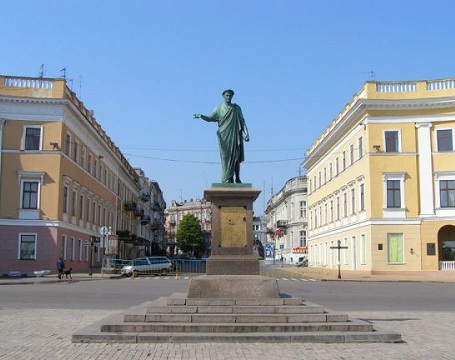

Monument to the Duke de Richelieu in Odessa (also
known as the Bronze Duke) is a full-length bronze monument dedicated
to Armand Emmanuel du Plessis, Duke de Richelieu, opened in 1828.
The first monument erected in Odessa.
De Richelieu
participated in the assault on Ishmael, and five years later he
settled in the Russian Empire for a long time. In 1803, Richelieu
became the mayor, and from 1805 to 1814 the governor-general of
Odessa. Odessans called him "our Duke" and considered him the
founder of the city, although by that time Odessa was already 8
years old. Through the efforts of the new mayor, the city turned
into a major trading port.
When the Bourbons regained the
throne, Duke left for France, where he became prime minister in the
government of Louis XVIII. He died on May 16, 1822 at the age of 55
in Paris from a cerebral hemorrhage.
History of creation
Having received the sad news from Paris about the death of
Richelieu, Count Langeron appealed to the population to start
raising funds for the construction of the monument. Count M. S.
Vorontsov, who took over the post of Novorossiysk Governor-General
in May 1823, ordered a monument to the famous sculptor I. P. Martos.
He became one of the last creations of this outstanding Russian
master.
The monument is a bronze statue of Richelieu in a
Roman toga with a scroll in his hand and three brass high reliefs
symbolizing agriculture, trade and justice.
Laid down June
30, 1827. The sculpture and high reliefs were cast in bronze by the
foundry master V.P. Ekimov in St. Petersburg. The pedestal of the
outstanding St. Petersburg architect A. I. Melnikov and architect F.
K. Boffo. The monument in the style of classicism is a bronze statue
of A.-E. Richelieu. The size of the figure is slightly larger than
natural. A square pedestal with a cornice made of pink polished
granite from the bank of the Southern Bug River (near Voznesensk),
donated by the Kherson landowner Skarzhinsky, is finished by
craftsman P. Dzhenari. The base of the pedestal is a stylobate in
the form of a truncated pyramid made of local limestone with four
granite steps.
Slabs and high reliefs are installed on the
sides of the pedestal in rectangular niches. On the front there is a
gilded brass plate with the inscription:
Duke Emmanuel de
Richelieu, who ruled the Novorossiysk region from 1803 to 1814 and
laid the foundation for the prosperity of Odessa, grateful to his
unforgettable labors, residents of all classes of this city and
provinces: Yekaterinoslav Kherson and Tauride, erected a monument to
this war in 1826 under the Governor-General of Novorossiysk,
Count-General.
On three sides there are bronze high-relief
images symbolizing trade, justice and agriculture.
The
installation of the monument was supervised by the architect F.K.
Boffo.
The opening of the bronze monument to Duke took place
on April 22, 1828.
Damage during the Crimean War
During
the Crimean War, the Anglo-French squadron fired on the city and
port. One of the cores exploded in the square near the monument and
damaged its pedestal with a fragment. After the war, a cast-iron
patch with a stylized cannonball was installed at the site of the
damage.
Events of 1969
In 1969, as part of the celebration
of the 175th anniversary of the founding of the city, it was
proposed to replace the monument and install in its place a monument
to Suvorov, whom the city committee of the CPSU called the true
founder of Odessa. Only as a result of Arkady Lvov's appeal to
Konstantin Simonov and joint actions, which ended with the
publication of a letter on the topic in the Nedelya newspaper, were
these plans prevented. Shortly after this publication, the Odessa
newspaper Znamya Kommunizma published an article stating: “In the
Committee for Geodesy and Cartography of the USSR. The monument to
Richelieu is protected by law.” This publication, de facto, annulled
the demolition proposal.
Location within the city
Address:
Primorsky Boulevard, 9. The monument faces the sea, right in front
of it is the Potemkin Stairs leading to the Marine Station. Behind
the monument are two buildings of official places, forming a
semicircular square, then - Ekaterininskaya Square. The monument is
successfully combined with the surrounding buildings and the
Potemkin Stairs.
Interesting Facts
Odessans say: "Look at
Duke from the second hatch" or "Look at Duke from the hatch." Viewed
from the plumbing manhole to the left of the monument, the scroll
and the folds of Duke's clothing bear a striking resemblance to male
genitalia. In Igor Gankevich's song “Walk in Odessa”, the fact about
the hatch is reflected as follows: “Smiling at Duke, I walk along
the boulevard; I don’t look at him from the second hatch ... "
It
is interesting that Themis on the bronze high relief is depicted
without a traditional blindfold.
The monument is not very similar
to the portrait of Richelieu, since Martos, according to art
historians, was an unimportant portrait painter and preferred to
copy the available sculptural samples. Duke, apparently, was given
the face of the first Roman emperor Gaius Julius Caesar Octavian
Augustus.